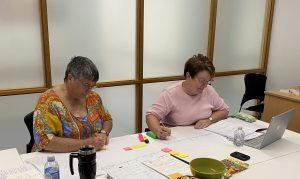Principle 6. Enabling accountability
Accountability requires meaningful and responsive community involvement, monitoring, evaluation and iteration in real time, reflecting on (and updating) shared goals.
- Coordinators should ensure processes are in place to appropriately govern and monitor the work, and ensure inclusive communication and regular feedback is provided.
- The planning work needs to be valued and seen as beneficial to all stakeholders and partners.
- Local governance of place-based health service planning initiatives through community reference groups and local connectors supports meaningful, responsive community involvement and accountability to the community and enhances sustainability.
- Cyclical and iterative (not rigid and time-bound) implementation strategies recognise that communities, services and networks comprise multiple stakeholders, with multiple levels of leadership that require flexible and responsive planning approaches. Continuous improvement is cyclical and evaluation of actions and outcomes can contribute to incremental and more significant improvement.
- Evaluation strategies may be adapted to different actions and shared goals and focus on process as well as outcomes. Early consideration of who will carry out evaluations is required, and how, will help to inform what data is collected, when and how it will be analysed. Evaluation and feedback loops can/should inform local groups and stakeholders as part of the planning cycle, as well as funding bodies.
- Planning and continuous improvement should be a cyclical process and this process repeated at regular and appropriate intervals.

Within each community, a local reference group was appointed to oversee and provide guidance on the project. A key facilitator of collaboration with the local reference group was the Local Connector (employed by the university) who helped with engagement and networking with local service providers and the community. The project team were accountable to this group and provided regular updates on progress and sought clarification for direction if needed. Actions could be tweaked or redirected if necessary. This also facilitated accountability of the various partners in implementation. Engaging with the local group encouraged local ownership of the work and may have contributed to sustainability beyond the project.
In addition, the project team met regularly with the full research team in relation to research design and data collection, analysis and reporting (Figure 1.6). Changes in approach were sometimes required based on progress and feasibility of activities within each community. Formal reporting was also conducted every quarter with funding bodies.


